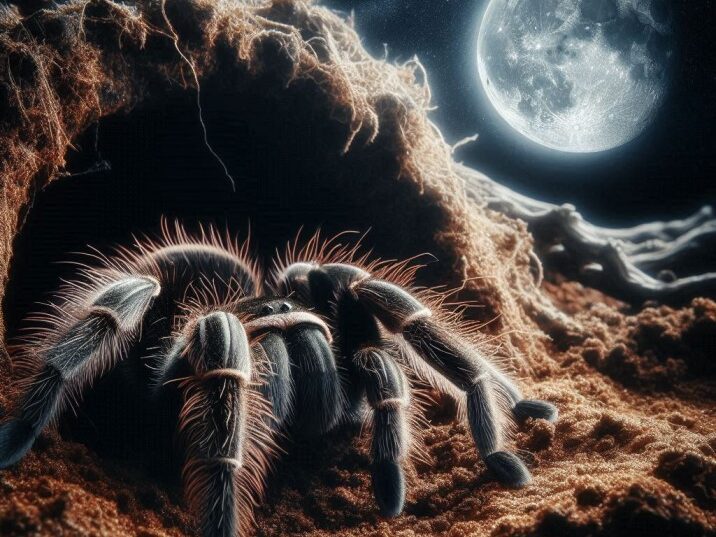Introduction
Table of Contents
The Lycosa tarantula, commonly known as the wolf spider, is one of nature’s most intriguing arachnids. Found predominantly in parts of Europe, including Italy, Spain, and the Mediterranean region, this spider has captured the interest of scientists and spider enthusiasts alike. Despite its fierce name, the Lycosa tarantula is not as dangerous as its reputation suggests. In this article, we will explore the characteristics, behavior, habitat, and life cycle of the Lycosa tarantula, providing you with a comprehensive understanding of this remarkable spider.

What is the Lycosa Tarantula?
This tarantula belongs to the wolf spider family, known for their hunting abilities. Unlike other spiders that spin webs to catch prey, wolf spiders rely on their speed and agility to hunt down insects and other small creatures. The Lycosa tarantula is one of the largest species in this family, with a body length that can reach up to 1.2 inches (3 cm).
Physical Appearance
The Lycosa tarantula is easily recognized by its large size and distinctive markings. Its body is covered in hairy bristles that give it a rugged appearance. The spider’s coloration typically ranges from brown to gray, with a characteristic stripe running down the center of its body. This stripe helps it blend into its surroundings, providing effective camouflage against predators.
Habitat and Distribution
This tarantula is native to the Mediterranean region, thriving in warm, dry climates. These spiders prefer habitats with loose, sandy soil where they can easily dig burrows. Their burrows serve as both a home and a hunting ground, where they wait patiently for prey to wander by.
Adaptation to Environment
One of the most fascinating aspects of the Lycosa tarantula is its ability to adapt to various environments. While they prefer dry, arid regions, they have also been found in grassy areas and even in agricultural fields. Their adaptability has allowed them to survive in regions where other spiders might struggle.
Behavior and Hunting Techniques
Unlike web-spinning spiders, this tarantula is a nocturnal hunter. During the day, it remains hidden in its burrow, emerging only at night to hunt. Its keen eyesight and swift movements make it an effective predator.
Hunting Strategy
These tarantulas uses its powerful legs to chase down prey, pouncing on them with remarkable speed. Once the prey is caught, the spider injects venom to subdue it. Although its venom is not dangerous to humans, it is potent enough to immobilize its prey quickly.
The Lycosa tarantula’s nocturnal nature is one of its most intriguing traits. Being active at night helps it avoid predators and increases its chances of catching prey. The spider’s eyes are specially adapted to low light, giving it an advantage in the dark.
Life Cycle and Reproduction
The life cycle is similar to that of other spiders, but with some unique twists. After mating, the female lays her eggs in a silk sac, which she carries with her until they hatch. This maternal care is uncommon among spiders and highlights the Lycosa tarantula’s unique behavior.
Mating Rituals
The mating process is a carefully choreographed event. The male approaches the female cautiously, often performing a dance to signal his intentions. If the female is receptive, they mate, and the male quickly retreats to avoid being eaten.
Table of Information:
| Feature | Details |
|---|---|
| Scientific Name | Lycosa tarantula |
| Common Name | Wolf Spider |
| Size | Up to 1.2 inches (3 cm) |
| Habitat | Mediterranean region, warm climates |
| Diet | Insects, small animals |
| Behavior | Nocturnal, solitary |
| Venom | Non-lethal to humans, used to immobilize prey |
| Lifespan | 2-3 years in the wild |
Myths and Facts About Lycosa Tarantula
It is surrounded by myths, particularly concerning its danger to humans. One of the most persistent myths is that its bite can cause severe symptoms or even death. However, the venom is relatively mild and poses little threat to humans.
Myth: The Lycosa Tarantula’s Bite is Deadly
This myth likely stems from the spider’s fierce appearance and the historical association of tarantulas with death in European folklore. In reality, a Lycosa tarantula bite may cause mild pain and swelling but is not life-threatening.
Conservation Status
It is not currently considered endangered, but habitat loss and environmental changes pose potential threats to its population. Conservation efforts focus on preserving its natural habitat and understanding its role in the ecosystem.
Role in the Ecosystem
As a predator, it plays a crucial role in controlling insect populations. By keeping these populations in check, it helps maintain a balanced ecosystem.
Conservation Efforts
Efforts to conserve the Lycosa tarantula include protecting its natural habitats and educating the public about its importance. Conservationists are also studying the effects of climate change on its distribution and behavior.
Conclusion
The Lycosa tarantula is a fascinating creature that has captivated the attention of scientists and nature lovers alike. Despite its intimidating appearance, it plays a vital role in the ecosystem and poses little threat to humans. Understanding this spider’s behavior, habitat, and role in nature helps dispel myths and highlights the importance of conservation efforts. Whether you’re a budding arachnologist or simply curious about the natural world, the Lycosa tarantula offers a glimpse into the incredible diversity of life on our planet.
FAQs
- What does the Lycosa tarantula eat?
- The Lycosa tarantula primarily eats insects and small animals.
- Is the Lycosa tarantula dangerous to humans?
- No, its venom is mild and not dangerous to humans.
- Where can you find the Lycosa tarantula?
- It is commonly found in the Mediterranean region.
- How does the Lycosa tarantula hunt?
- It hunts at night using its speed and sharp eyesight.
- What is the lifespan of a Lycosa tarantula?
- The Lycosa tarantula typically lives for 2-3 years in the wild.

